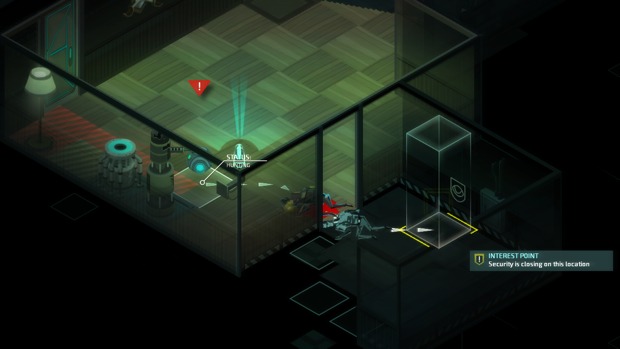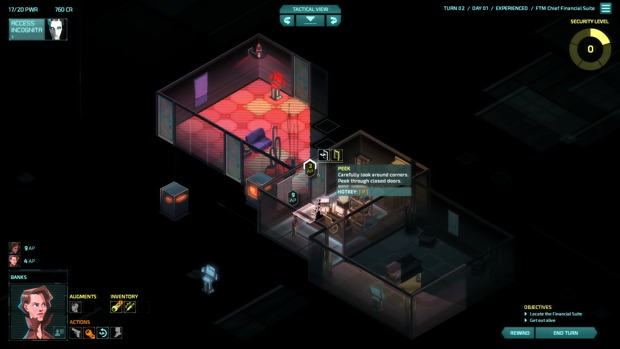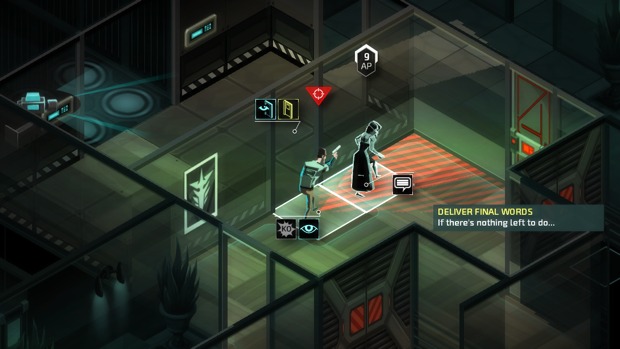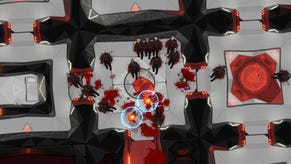The Secret Behind Invisible, Inc. Is Giving You Loads Of Information
This is The Mechanic, where Alex Wiltshire invites developers to discuss the inner workings of their games. This time, Invisible, Inc. [official site].
Invisible, Inc.’s defining features aren’t its most obvious, and yet they’re all about making things obvious. This turn-based tactics game about hacking and sneaking through procedurally generated levels thrives on them, because they make you feel like a mastermind, even though your agents are outnumbered and outgunned. They make every turn a exercise in deliberate planning, and they allow you to pull the most fantastically elaborate and elegant heists. And you’d never think such simple concepts could have so much power:
THE MECHANIC: Peeking and observing
Every agent can use peek and observe. Peek lets an agent peer through a door, if next to one, or to crane around a wall to see what it obscures. Observing allows you to predict guards’ patrol patterns, drawing a path for their future movements on the ground. Both sound simple, but they give you a huge amount of knowledge, which when paired with hacking cameras and beating down guards, can crack open levels that initially look impregnable.
While they’re cornerstones of the finished game, they weren’t part of its first prototypes. In fact, they were added to fill a hole. Invisible, Inc. was first conceived as a turn-based take on Syndicate, and that meant it had lots of combat. It had different guns, ammo and damage types, and characters had health points. It was OK, but the design team realised it wasn’t anything new. So, led by designer Jason Dreger and studio head Jamie Cheng, they took it back to the drawing board to develop one aspect, its stealth. And that led them into taking another look at Klei’s previous game, the excellent stealth platformer, Mark of the Ninja.
What you can see in Mark of the Ninja depends on your character’s line of sight, and that means you spend a lot of time gathering information, clinging to walls and peeking through doorways in order to know as much as you can to plan your next movements. Dreger and the team, having come directly from Ninja, began to see that this kind of information gathering could also work in a turn-based game. “We wanted players to be able to think a few turns ahead,” says Dreger. “Instead of just going up to a door and then ending their turn, they’re going to be like, ‘I’m going to go up to the door, peek, and if there’s a guard I’m going to observe and then know that in two turns he’ll be there.’ It was to bring their thinking up to the next level.”
Both peek and observe cost valuable ability points that could be used on movement, but all players know they’re well worth the expenditure. That’s despite the fact that opening doors and many other abilities, such as hacking, cost absolutely nothing, a detail that on first glance seems counter-intuitive. Surely peeking takes less time than opening a door? And door-opening costs time in most other tactics games. But Klei noticed that players didn’t like the flow of the game if they paid to open doors. “Someone would move a character to a doorway, and they’d end up with not having enough points to hack that computer or open the door. It was always very frustrating,” says Dreger.
But they didn’t mind paying for information. In fact, they didn’t like peeking when it was free. “It made it boring. ‘Why do I have to do it? Why can’t I just do it all the time?’ So leaving it with a cost was a good thing, but it makes for a strange interface where some of your actions are free, some are not. Why is peeking more expensive than opening a door? So it was weird, but it worked.”
The information you can gather in Invisible, Inc. is rich and also absolute, in the sense that you can always tell whether a location is in view of the enemy or not. “The idea of perfect information in Mark of the Ninja was that having binary information for whether you’re seen or not seen and whether you’re heard or not heard means you can play on a different level. You’re not sensing if the guy can see you, you know if he’ll see you at this point so you can either avoid or use that. We really wanted that to be in Invisible, Inc.”
Perfect information, and lots of it, wasn’t so much of a game design problem as a UI one, and making it look good and readable was a process that took a great deal of the game’s development time. Again, there are weirdnesses in how Klei implemented it. For instance, though you don’t get a button for peeking unless you’re against a door or corner, you can peek anywhere using the hotkey P, and if you do, you might just see something extra. “We simply didn’t want that peek icon showing up everywhere,” says Dreger, and apparently if anyone has noticed, no one has complained.
Weird, too, is the way line-of-sight works. One thing is the way that when your agents are in cover, they’re invisible to all guards in front and to the sides of them. “The solution we came up with is kind of a hack, it’s unbelievable,” co-designer James Lantz explains in his excellent GDC talk about designing procedural stealth in Invisible, Inc., because your agent can often appear to be directly in view of a guard. “But what we lost in this intuitive scenario, we gained back again in high-level planning because we gave players a clear and simple system they could use and abuse.”
Another is the way the game resolves showing what can be seen. At first, the game was be very specific about what was in view of agents and what wasn’t, shading the grid in an aliased way, dark for unseen, bright for seen, but Klei felt the effect looked dated. “So we put in a new rendering system that drew these nice lines, and as agents moved they’d expand out in realtime. It looked really good, but it wasn’t precise.” The solution was shading the grid in reds to denote areas being watched by enemy guards, drones and cameras, and yellows to show squares that are hidden from them, so you can immediately tell where is safe. But what the game also does is to mark locations that are being watched, even if you can’t see the enemy. “That’s a weird one,” Dreger says. Turns out there are a lot of weird things in Invisible, Inc. And again, it’s down to player flow. Klein saw that without this feature, players tended to blunder into view of unseen cameras without peeking first, and often find their entire run ended in a single turn by nearby guards. Seeing the danger beforehand made Invisible, Inc. far more fun.
You’d think that all this information would make you feel overpowered, but you rarely do. In fact, you feel constant stress, despite having such certainty. A lot of it is down to the constantly up-ticking alarm level, which raises the difficulty as you take more turns. But more subtly, you’re also contending with the wildcard of what the AI will do when you’re not watching it. “Yeah, it’s interesting that in standard tactics games the random number element comes in shooting and critical hits and things like that, but in Invisible, Inc. it’s the location of the guards and where they randomly change their patrol route to,” says Dreger. Invisible, Inc. is not a game in which you can easily incapacitate guards indefinitely, so you’ll frequently encounter them again in having to recross areas as you search for objectives and get to the exit.
“The information can change behind you,” is the way that Dreger puts it. He was inspired by the original X-COM (which makes, with Syndicate, for two ‘90s Brit tactics games that Invisible, Inc. references), specifically the way that missions were so open and self-directed. You could go into a mission, encounter aliens and incur enough injuries and deaths among your squad to make assaulting the crashed UFO a bad idea, so you’d cut your losses, pick up as many sectoid carcasses as your troops could carry (to avoid a complete dead loss), and return to the dropship. “I love that you had that choice,” Dreger says, and in levels of Invisible, Inc. you can also cut and run, playing your agents’ safety against the risk of not being prepared enough for the final level.
That’s the beauty of having all this information to play with in Invisible, Inc. It allows you to focus on the bigger questions, from what your agents will do several turns in advance to the overall goal of amassing the skills you need and the agents you want in order to beat the endgame. When you step back, sure, Invisible, Inc. is a bit weird, but this is one of those cases of weirdness only making a game better.












